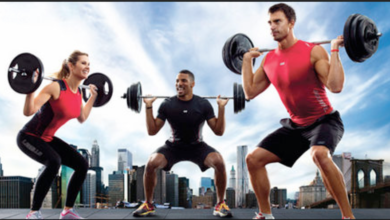How To Build Muscle and Strength In Only 3 Days Per Week

Most people believe that a muscle-bound body is built from endless hours in the gym
over the course of 5-7 days per week. Well this is exactly how to build muscle.
But what if you don’t have that kind of time?
What if you do well to get to the gym only 3 days per week?
Better yet, what if you just aren’t interested in training so much?
Is there another way on how to build muscle and strength without living in the gym?
There is, and I’m going to give you a workout plan at the end of this article, but first I
want to briefly explain some guidelines on how training for muscle gain works, so you
can later set up your own training programs using the this particular methodology.
Fool-Proof Muscle Gain Guide
In an article I co-wrote for T-Nation in January 2013, we covered the similarities of
muscle mass levels among elite powerlifters, strongmen, and bodybuilders. If you look at
their training programs, they differ in methodology, equipment, and structure, but the
principles are very similar.
While closely analyzing their programs, you’ll see 2 things in common.
The first aspect is a consistent focus on progressive overload – an aim to get stronger
over time. This is a given. Look at any elite lifter in their respective domain. The biggest
guys are much stronger than the average joe.
Most of these people are doing what we call ‘strength training plan’ in which we aim to add
more weight to the bar using the lower rep ranges (1-6 reps) on the big lifts (squats,
deadlifts, chins, bench press, rows).
The second aspect is the inclusion of what is known as accessory movements, which
are what some might call ‘isolation work’ where we do higher rep sets for movements
like hyperextensions, chest flyes, floor presses, high rows, calf workouts, arm exercises,
etc. Some people, including myself, even call these exercises ‘pump work.’
Your Guide On How To Build Muscle…

So what can we learn from this?
It’s pretty simple. When the ultimate goal is strength and muscle gain you should aim to
base your workouts around strength first, followed closely by high(er) rep work to add
more volume, which produces the fatigue necessary to on how many reps to build muscle and making gains.
So What Does It Look Like?
For the sake of this programming, we’re going to think of this in terms of Primary and
Secondary movements.
Primary movements are those you place the most focus on, and secondary
movements are the ones you utilize to provide the volume and fatigue that aids in the
muscle building process.
Primary movements are the ‘money’ exercises – deadlifts, squats(how to squat), presses, pulls, and all
the major variations. if you can load the bar excessively, and it’s considered a
compound movement, you can label it as primary.
Avoid going to absolute failure on these due to the possibility of injury – focus on leaving
one rep in the tank, and never go for a rep if you’re not sure you can get it.
Secondary movements are movements that hit the same muscles as the primary, but
are generally lighter, and more muscle-focused or even considered isolation
movements. So imagine most machine-based pulling, pressing, and other stuff like
cable crossovers, leg curls, extensions, and calf raises.
The goal with secondary movements is to reach momentary muscular fatigue. A good
rule of thumb is to aim for the pump on these sets. So if you start out too conservative
on the first set and can perform more than the prescribed rep range, go ahead and do
so. Adjust the next few sets, and make a note in your journal to start with a heavier
weight in the next session.
Stacking Movements For Effective Programming
To keep things very simple and easy to manage, we’ll set up the training in a push/pull
fashion.
On your Push Days, you’ll focus primarily on squats, flat press and incline presses with
a few opposing movements to provide balance in your program.
On the Pull Days, you’ll do exactly the opposite.
Here’s an example program to get your started.
A – Push Day
1. Squat 4×5 – (2m)
2a. Leg extension 4×12-15 – (1m)
2b. Hyperextension 4×8-10 (1m)
3. Bench Press 4×5 – (2m)
4a. Incline DB Squeeze Press 4×12-15 – (1m)
4b. Lat pulldown 4×8-10 – (1m)
5a. Tricep extension 3×12-15 – (30s)
5b. Seated Calf raise 3×12-15 – (30s)
B – Pull Day
1. Romanian Deadlift 4×5 – (2m)
2a. Leg curl 4×12-15 – (1m)
2b. Walking lunge 4×8-10 (1m)
3. Weighted Chin-ups 4×5 – (2m)
4a. Seated Cable row 4×12-15 – (1m)
4b. Arnold DB presses 4×8-10 – (1m)
5. Barbell bicep curl 3×12-15 – (30s)
Key:
As you’ll notice, the Primary movements are the lower rep ranges. They’re also number
1 and number 3 in each program. The Secondary movements are everything else in
addition to 1 and 3.
Note: rest periods are in the parentheses
Example: 2 minutes = (2m). 30 seconds = (30s)

Supersets
A number followed by a letter (4a, 4b) means this is a supersets workout. You will simply alternate
each movement utilizing the rest period prescribed.
Example: Seated cable rows are alternated with Arnold DB presses with a 1 minute rest
period in between each set.
Progression
The goal for the primary movements is to use about 75-80% of your 1-rep max. So if
you have a 225-pound bench press, you would start out with 165-180 pounds for
your work sets. Once you can get more than 6 reps on your first set, add 3-5% to the
bar.
For secondary movements, aim to add weight to these when you can hit the top of the
rep range for every set.
Warming Up
Start with some light activity such as a brisk walk, or cycling for about 5-6 minutes.
Jumping rope for a minute or two can also suffice. You should always warm up before working out.
A good idea is to start with 50% of your work load for the day for a few sets of 10.
Increase by 10% for sets of 3 until you arrive at your working weights for the day.
Always take the time to warm up properly. If you can get warm with fewer sets, that’s
fine. If you need more, then do more. There are no hard rules here, but never go into a
heavy workout without warming up first.
Movement Exchanges
I encourage you to run the program for at least 6 weeks before making any changes. You can also check out the best muscle building supplements as well. It’s likely that you will eventually stall out on a lift, and find it hard to add weight to the bar
after a while. If you start conservative and add weight slowly, it might take you a long
time before you reach a plateau.
If you find yourself stagnating on a lift, you can swap it out for something similar. For
instance, if you’re doing bench press, you can switch to weighted dips, incline dumbbell
press, or an overhead press.
If you’re not making any more progress on the Romanian deadlifts, switch to another
variation like the conventional deadlift, or sumo version. Always make sure your primary
movements are compound exercises.
Remember to focus on getting stronger, and focus on feeling the secondary
movements. Try to connect with the feeling you produce in your muscles as they
fatigue.
[author_bio name=”yes” avatar=”yes”]




